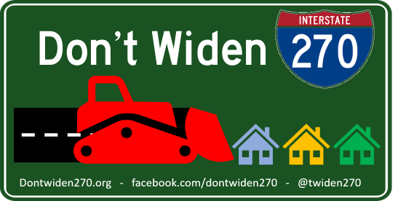Despite all the promises from the Governor, MDOT Secretary Greg Slater, and Peter Franchot, the Beltway toll lanes are back in the P3 plan. For starters, where will MDOT put them? In tunnels, as MDOT’s private partner Transurban does in Australia?
The State tolling authority announced a one-and-done change to the onerous proposed tolls for I-495/I-270. The Maryland Transportation Authority (MDTA) will reduce the rock bottom, middle-of-the-night minimum toll rate by 3¢. Yes, 3¢. No changes to the $50 rush hour tolls.
On October 1, MDOT issued the massive Supplemental Draft Environmental Impact Statement (SDEIS) for the project’s Phase 1 South. The public and officials have just 45 days to review, analyze, and comment on 8,231 pages.
And then there’s MDOT’s brand new name for those lanes you pay money to drive on.
You can read about these developments, below, following this action item.
Action Item
Sign up for the October 13 CABE Town Hall meeting: For insight, updates, and all the encouragement you need to keep fighting the P3 project, register for the virtual Town Hall led by our valued partner Citizens Against Beltway Expansion (CABE). You’ll hear from elected officials -- including Rockville’s Mayor Bridget Newton -- advocates and grassroots activists. Click here for the registration form and all the Town Hall details.
The toll-lane project will include the Beltway…again
Our September 19 newsletter quoted the CEO of Transurban saying his company would encircle Washington, DC, with toll lanes. The very next day, MDOT posted a revised project map, confirming what the CEO had already announced. The Beltway will get toll lanes if MDOT and Transurban get their way.
From the OP Lanes Website homepage
This map should be an eye-opener for every politician who acted on the belief that the Beltway would be spared, and for every person who trusts what the Governor, Secretary Slater, and Comptroller Franchot tell us about the project.
The map says we and our elected officials must stop this P3 before the State hands over our public infrastructure, transportation policy, and options to Transurban, the Australian conglomerate that makes no secret of its ambitions. There are smarter, fairer, better ways to improve regional transportation. This P3 is about the worst choice our State can make.
Need more proof? Look at the spaghetti-mess MDOT and Transurban have planned for the already notorious northern bottleneck on I-270 at I-370. (The purple lines are the I-270 express lane project. The number of lanes is indicated. See the original schematic here, p. 6.)
From MDTA Final I-495/I-270 Preliminary Toll Rate Due Diligence Report (p. 6)
MDOT has rebranded the I-495/I-270 toll lanes!
If a State Department of Transportation can shoot itself in the foot while giving itself a makeover, that’s what MDOT just did. On September 20, MDOT debuted a new name and image for the P3 project: OP Lanes!
OP stands for “Opportunity” and “Options.” See the new OP Lanes website! See the new OP Lanes video, featuring the cutest puppy and happy children running through the grass.
Our response to MDOT: Call it an OP Lane or a Golden Goose lane, or whatever you want. It’s a toll lane. An unwanted, congestion-worsening, exorbitantly priced, backward-looking, environment-harming toll lane.
Faced with vast inequities, MDTA congratulates itself on 3¢ toll rate reduction
The MDTA Board can’t claim it didn’t know what was at stake when it announced that P3 rush hour tolls would stay sky-high, and that the yearly escalation rate of 2.1% above the annual consumer price index wouldn’t change.
When the public spoke during the toll setting comment period earlier this year, the Board heard in detail about the harm the proposed rates would cause: the $50 rush hour tolls; the social/racial/economic injustice of the regressive tax; the increased congestion and decreased safety in the reduced number of free lanes; and on and on. See powerful examples of the public testimony here.
The Board’s response was to declare they’d “listened to the public” and reduced the minimum toll rate by 3¢/mile but kept all other rates unchanged because that “best suited the financial viability of the project.”
The SDEIS has over 8,000 pages. The public is getting a first look now.
MDOT posted the federally-mandated SDEIS for the P3 project on October 1. This is the last Environmental Impact Statement that federal agencies evaluating the project will review. It’s also the last one the public will see before a Final EIS is issued – and MDOT’s not saying when that will be.
The public needs much more than 45 days to review this document. That’s why the Sierra Club and 44 other organizations, including DontWiden270.org, sent a letter to the Federal Highway Administration and MDOT, requesting an extension of the comment period.
We’ll keep you updated on the contents of the SDEIS and let you know how to make your voice heard during this critical review. You can access MDOT’s instructions on providing feedback here.
As for what happened to the crush of DEIS public comments submitted ahead of last November’s deadline, MDOT posted this dismissive statement on the OP Lane site: “MDOT SHA and FHWA continue to consider the nearly 3,000 comments received as part of the DEIS and public hearings held last fall.”
Some early analysis of the SDEIS
The Washington Post finds evidence in the SDEIS that congestion would not improve with the toll lanes.
The Maryland Transit Opportunities Coalition cites blatant errors in the SDEIS traffic analysis.
WTOP says, “The [SDEIS] showed minimal improvement for driving from the Capital Beltway to Interstate 370 in Rockville, with the addition of the toll lanes improving the drive by 1 mph.”


